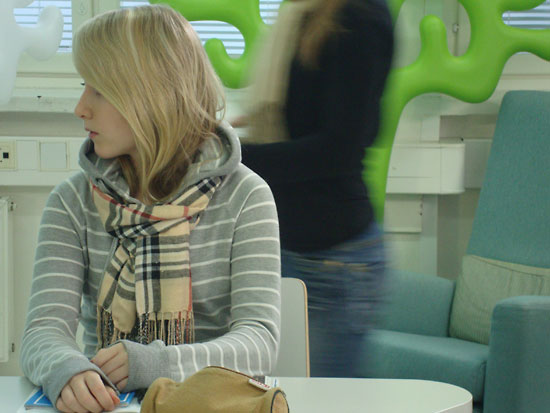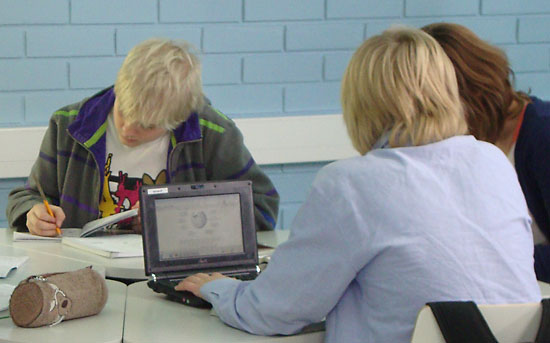An electronic portfolio called the Learning Diary allows students and teachers at Kauniainen’s Dream School to store materials, track progress and build on prior experiences. It shows how education is evolving in Finland.
Jussi A. comes home after evening ice hockey practice, just in time for dinner with his family. Afterwards, he logs on to his school account on his laptop and checks his Learning Diary, looking over the presentations he submitted yesterday. For one of his physics assignments, he and two friends decided to answer the questions by creating a short film, which they then filed in their Learning Diary. Other students chose various formats: One used a slide presentation, a few others handed in word processing documents.
Jussi’s teacher, Mrs B., has reviewed the submission, and left annotations and comments for Jussi and his partners to read. The teacher’s comments include reference to the self-evaluation of the assignment that Jussi had submitted earlier. All students are allowed to comment on their assignments this way. The teacher can evaluate, grade and comment on the work in the Learning Diary at any time or place via the internet.
The Learning Diary forms an electronic portfolio, a central hub where students can collect all their materials with net-based (cloud-based) tools. This portfolio can hold all their work – picture and word presentations, sound and video files. It can be used over multiple school years, and the goal is that the student can refer to up to 12 years’ work. Prior projects can be built upon, be used across the curriculum and serve as a source of knowledge and inspiration for others when shared.
For the teacher it is a one-stop collection of student assignments, both graded and ungraded. In one screen view the teacher can see assignments awaiting commentary or grade, regardless of file type or mode of production. The Learning Diary is a unique way of allowing students to build on prior experiences.
Remarkable inversion in education

Photo: Dream School
At the start of the project the teacher creates and shares a tag with the students. This tag contains the instructions for an assignment, for example, a book report, a presentation or an essay. The student does the work with a tool of his or her choice – not always the teacher’s choice: blog, wiki, video, sound file, presentation software or some other mode. The teacher can follow the students’ progress, comment and make suggestions along the way. When ready, the student places a link to his work in the Learning Diary, completes a self-assessment and sends the teacher a request to assess the finished product.
Development of the Learning Diary started with the needs of the teaching staff at the Kasavuori School in Kauniainen, outside of Helsinki. Using a multitude of net-based tools and the need to incorporate video, pictures, and sound files made it necessary to create a place that could display and store work produced in various file formats and with a multitude of tools.
Nothing else quite like it exists in education – in Finland or elsewhere. The Learning Diary itself is a consequence, not the source of change. The actual source of change is a remarkable inversion in education, envisioned by the community and the school together.
Students as knowledge providers
Kauniainen is a small town west of Helsinki, with a well-educated population. At the heart of the development process is a realisation that the good education of today would not be good enough for tomorrow. There was a conviction that schooling today was not sufficiently preparing their kids for a world that will change even more rapidly than it does today. We needed to evolve and change – not just improve existing processes.
In 2006 the local school authority brought in leading thinkers from outside to brainstorm with the community and the school to help define a progressive pathway to reinvent what was already an excellent school system. This was the new covenant between the community and the school – to do everything possible to encourage all students to learn. Consistent with the ambitions and results, the local school authority named it the Dream School.
The goal is to defragment and unify the process of learning. The Learning Diary represents one of our enabling tools. This student-centric pedagogy strives to recognise and harness the rapidly evolving real-world knowledge our students possess. Instead of the curriculum being a distribution mechanism for fixed knowledge, it incorporates the knowledge students themselves create and have to share. In this rethink, the teacher is not the only source of knowledge. The student is also invested in the knowledge development and sharing process.
The Dream School ambition required rethinking the use of IT to address simultaneous but opposite needs: to increase efficient and creative IT use, and to cut costs. The most important communication takes place face to face, and the aim was to create good tools, practises and savings that could be reinvested in greater teacher involvement and easier ways to tailor the learning process.
Open source empowers users
To support their goals, the parties involved opted for an open source, cloud-based technology model. Closed models are more expensive, and they do not harness the necessary innovation. For example, the Learning Diary is an open source application, developed in collaboration with a supplier within the framework of a public–private partnership.

Photo: Dream School
The Linux-based Dream School service platform utilises open source products that are cost-effective and easy to use. The users are also active participants in the development of tools that meet their demands. This is a marked contrast to the model with which the education sector is familiar: software purchasing.
Within the framework of the public–private partnership, renowned companies provide services to the school, such as educational software, communication tools and administrative tools. The school participates in product development. Importantly, the partner companies can market these services on an open source basis to other schools.
The focal point is the empowered user. With a single sign-in, a user can access all services and communication. The aim is to shorten the distance between the user and what he or she wants to accomplish. All parts of the system are economical, energy efficient and environmentally sound. The ease and reliability of the system form motivating factors for the users.
Innovation and development is ongoing. The initiatives to further develop the Dream School concept in the areas of school administration, decision-making, assessment, pedagogy and IT are continuously being developed and improved. The Dream School has several other initiatives and ongoing public–private partnership projects with universities, researchers and developers of learning materials – including games.
Links:
Dream School info and news
Dream School animation
By Sirkku Nikamaa, February 2011



